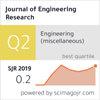Life cycle assessment (LCA) and the influence of alkaline activator content on mechanical and microstructural properties of geopolymer mortar
IF 2.2
4区 工程技术
Q3 ENGINEERING, MULTIDISCIPLINARY
引用次数: 0
Abstract
The geopolymer binder is gaining prominence as an eco-friendly alternative to ordinary Portland cement (OPC), aiming to decrease CO2 emissions during the manufacturing of OPC. Geopolymers, which are mineral-based polymers formed from materials rich in silicates and aluminates, undergo a complex process of aluminosilicate gel creation through polymerization when activated by alkaline substances. The proportion of alkaline solutions used plays a pivotal role in the process of geopolymerization. Hence, comprehending the impact of alkaline activator content on geopolymers' behavior is imperative. To address this, a study was conducted to assess how the ratio of Na2SiO3 to NaOH and the concentration of NaOH affect the synthesis of geopolymer mortar. The mechanical and microstructural characteristics of the geopolymer mortar samples were thoroughly examined. The findings demonstrate that samples with a Na2SiO3 to NaOH ratio of 1.5 and 16 M NaOH concentration exhibited the highest compressive strength around 36 MPa at 60 °C. The emergence of the geopolymer binder as an ecologically viable alternative to OPC is becoming increasingly evident. This substitution not only addresses sustainability concerns but also contributes to the reduction of CO2 emissions during the production of OPC. Geopolymers, compounds characterized by inorganic polymerization, are synthesized using source materials abundant in silicates and aluminates. These raw materials, upon activation with alkaline substances, undergo a sophisticated process resulting in the formation of intricate aluminosilicate gels. The LCA of GP binder has much lower values of Embodied energy (EE) and Global Warming Potential (GWP) than the OPC based mortar, with 94% and 97% reductions respectively.
生命周期评估(LCA)及碱性活化剂含量对土工聚合物砂浆机械和微观结构特性的影响
作为普通硅酸盐水泥(OPC)的环保替代品,这种地聚合物粘合剂正日益受到重视,其目的是减少OPC生产过程中的二氧化碳排放。地聚合物是由富含硅酸盐和铝酸盐的材料形成的矿物基聚合物,当被碱性物质激活时,通过聚合产生铝硅酸盐凝胶的复杂过程。碱溶液的配比在地聚合过程中起着关键作用。因此,了解碱性活化剂含量对地聚合物行为的影响是必要的。为了解决这个问题,进行了一项研究,以评估Na2SiO3与NaOH的比例和NaOH的浓度如何影响地聚合物砂浆的合成。对地聚合物砂浆试样的力学和微观结构特征进行了全面的研究。结果表明,Na2SiO3 / NaOH浓度为1.5 M和16 M时,样品在60°C下的抗压强度最高,约为36 MPa。地聚合物粘结剂作为一种生态可行的OPC替代品的出现越来越明显。这种替代不仅解决了可持续性问题,而且有助于减少OPC生产过程中的二氧化碳排放。地聚合物是利用富含硅酸盐和铝酸盐的原料合成的以无机聚合为特征的化合物。这些原料经碱性物质活化后,经过一个复杂的过程,形成复杂的铝硅酸盐凝胶。与OPC基砂浆相比,GP粘结剂的LCA具有更低的体现能(EE)和全球变暖潜能值(GWP),分别降低了94%和97%。
本文章由计算机程序翻译,如有差异,请以英文原文为准。
求助全文
约1分钟内获得全文
求助全文
来源期刊

Journal of Engineering Research
ENGINEERING, MULTIDISCIPLINARY-
CiteScore
1.60
自引率
10.00%
发文量
181
审稿时长
20 weeks
期刊介绍:
Journal of Engineering Research (JER) is a international, peer reviewed journal which publishes full length original research papers, reviews, case studies related to all areas of Engineering such as: Civil, Mechanical, Industrial, Electrical, Computer, Chemical, Petroleum, Aerospace, Architectural, Biomedical, Coastal, Environmental, Marine & Ocean, Metallurgical & Materials, software, Surveying, Systems and Manufacturing Engineering. In particular, JER focuses on innovative approaches and methods that contribute to solving the environmental and manufacturing problems, which exist primarily in the Arabian Gulf region and the Middle East countries. Kuwait University used to publish the Journal "Kuwait Journal of Science and Engineering" (ISSN: 1024-8684), which included Science and Engineering articles since 1974. In 2011 the decision was taken to split KJSE into two independent Journals - "Journal of Engineering Research "(JER) and "Kuwait Journal of Science" (KJS).
 求助内容:
求助内容: 应助结果提醒方式:
应助结果提醒方式:


